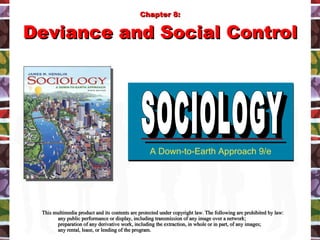C08 Henslin9e
- 1. This multimedia product and its contents are protected under copyright law. The following are prohibited by law: any public performance or display, including transmission of any image over a network; preparation of any derivative work, including the extraction, in whole or in part, of any images; any rental, lease, or lending of the program. A Down-to-Earth Approach 9/e SOCIOLOGY SOCIOLOGY Chapter 8: Deviance and Social Control
- 2. â It is not the act itself, but the reactions to the act, that make something deviant.â Howard Becker, 1966 Copyright ÂĐ Allyn & Bacon 2008 What is Deviance?
- 3. Relative Deviance What is Deviant to Some is not Deviant to Others â Devianceâ is Nonjudgmental Term Copyright ÂĐ Allyn & Bacon 2008 What is Deviance?
- 4. Crime Violation of Norms as Laws Deviance Violation of Rules or Norms Stigma Blemishes on âNormalâ Identity Copyright ÂĐ Allyn & Bacon 2008 Deviance Terminology
- 5. Makes Behavior Predictable No Norms - Social Chaos Social Control Groupâs Formal and Informal Means of Enforcing Norms Copyright ÂĐ Allyn & Bacon 2008 Norms Make Social Life Possible
- 6. Negative Sanctions Positive Sanctions Copyright ÂĐ Allyn & Bacon 2008 Sanctions
- 7. Shaming is a Sanction Can Be Centerpiece of Public Ritual Degradation Ceremony Copyright ÂĐ Allyn & Bacon 2008 Shaming and Degradation Ceremonies
- 8. Sociobiology Look for Answers Inside Individuals Genetic Predispositions Copyright ÂĐ Allyn & Bacon 2008 Explanations of Deviance
- 9. Psychology Focuses on Abnormalities Within Individuals Personality Disorders Deviant Personalities Copyright ÂĐ Allyn & Bacon 2008 Explanations of Deviance
- 10. Sociology Look for Answers Outside Individuals Socialization Membership in Subcultures Social Class Copyright ÂĐ Allyn & Bacon 2008 Explanations of Deviance
- 11. Families Friends, Neighbors Subcultures Prison or Freedom? Copyright ÂĐ Allyn & Bacon 2008 Symbolic Interactionist Perspective Differential Association Theory
- 12. Inner Controls Morality Conscience Religious Principles Copyright ÂĐ Allyn & Bacon 2008 Symbolic Interactionist Perspective Control Theory
- 13. Outer Controls Attachments Commitments Involvements Beliefs that Actions are Morally Wrong Copyright ÂĐ Allyn & Bacon 2008 Symbolic Interactionist Perspective Control Theory
- 14. Focuses on the Significance of Labels Labels Become Part of Self-Concept Propel Towards or Away from Deviance Copyright ÂĐ Allyn & Bacon 2008 Symbolic Interactionist Perspective Labeling Theory
- 15. Denial of Responsibility Denial of Injury Denial of a Victim Copyright ÂĐ Allyn & Bacon 2008 Symbolic Interactionist Perspective Rejecting Labels
- 16. Condemnation of Condemners Appeal to Higher Loyalties Copyright ÂĐ Allyn & Bacon 2008 Symbolic Interactionist Perspective Rejecting Labels
- 17. Embracing Labels - Outlaw Bikers The Power of Labels - Saints and Roughnecks Copyright ÂĐ Allyn & Bacon 2008 Symbolic Interactionist Perspective Labeling Theory
- 18. Clarifies Moral Boundaries and Affirms Norms Promotes Social Unity Promotes Social Change Copyright ÂĐ Allyn & Bacon 2008 Functionalist Perspective Can Deviance Be Functional?
- 19. Social Values Produce Deviance Cultural Goals Institutional Means Strain Leads to Anomie Copyright ÂĐ Allyn & Bacon 2008 Functionalist Perspective Strain Theory
- 20. Innovators Ritualism Retreatism Rebellion Copyright ÂĐ Allyn & Bacon 2008 Functionalist Perspective Four Deviant Paths
- 21. Copyright ÂĐ Allyn & Bacon 2008
- 22. Copyright ÂĐ Allyn & Bacon 2008
- 23. Copyright ÂĐ Allyn & Bacon 2008
- 24. Copyright ÂĐ Allyn & Bacon 2008
- 25. Copyright ÂĐ Allyn & Bacon 2008
- 26. Unequal Access to Institutional Means to Success Street Crime White-Collar Crime Gender and Crime Copyright ÂĐ Allyn & Bacon 2008 Functionalist Perspective Illegitimate Opportunity Structures
- 27. Copyright ÂĐ Allyn & Bacon 2008
- 28. Copyright ÂĐ Allyn & Bacon 2008
- 29. Class, Crime, and the Criminal Justice System Power and Inequality Capitalist Class Working Class Marginal Working Class The Law as an Instrument of Oppression Copyright ÂĐ Allyn & Bacon 2008 The Conflict Perspective
- 30. Copyright ÂĐ Allyn & Bacon 2008 Reaction to Deviance Street Crime and Prisons
- 31. Copyright ÂĐ Allyn & Bacon 2008
- 32. Copyright ÂĐ Allyn & Bacon 2008
- 33. Copyright ÂĐ Allyn & Bacon 2008 Reaction to Deviance Street Crime and Prisons The Decline of Crime
- 34. Copyright ÂĐ Allyn & Bacon 2008 Reaction to Deviance Street Crime and Prisons The Decline of Crime Recidivism
- 35. Copyright ÂĐ Allyn & Bacon 2008
- 36. Copyright ÂĐ Allyn & Bacon 2008 Reaction to Deviance Street Crime and Prisons The Decline of Crime Recidivism The Death Penalty Bias
- 37. Copyright ÂĐ Allyn & Bacon 2008
- 38. Copyright ÂĐ Allyn & Bacon 2008
- 39. Legal Change Hate Crimes Copyright ÂĐ Allyn & Bacon 2008 Reaction to Deviance
- 40. Copyright ÂĐ Allyn & Bacon 2008
- 41. Legal Change Hate Crimes Trouble with Statistics Copyright ÂĐ Allyn & Bacon 2008 Medicalization of Deviance Neither Mental nor Illness? Homeless Mentally Ill Need for More Humane Approach Reaction to Deviance
- 42. A Down-to-Earth Approach 9/e SOCIOLOGY SOCIOLOGY Chapter 8: Deviance and Social Control









































